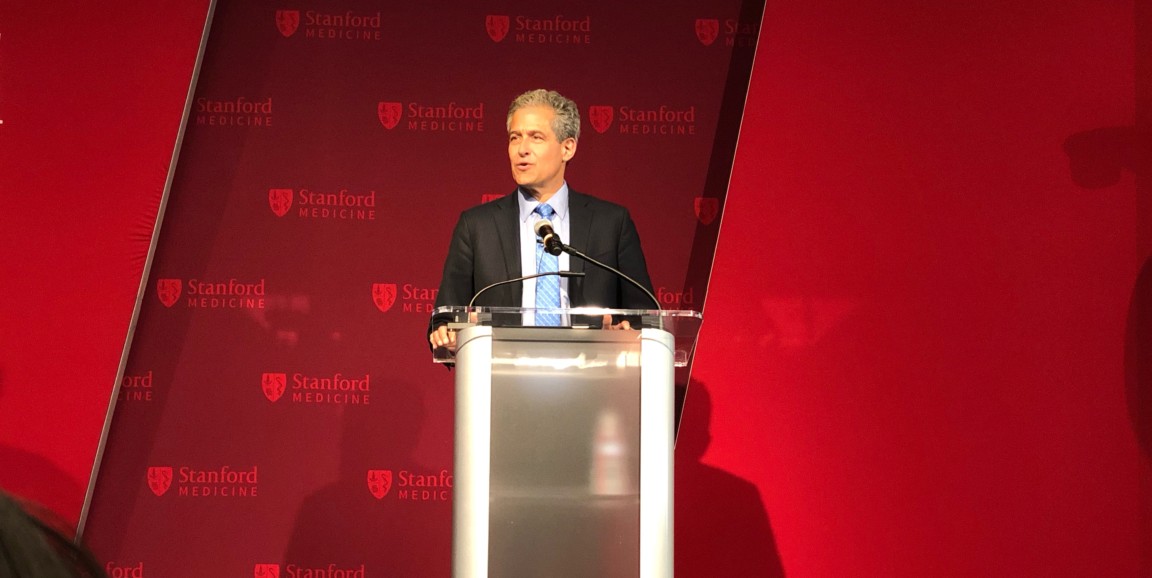Many of the factors that have biggest influence on health outcomes are outside of the health care system. Understanding and treating those factors -- such as homelessness, food insecurity, poverty, lack of transportation, and others -- is essential to improve health in America, said Richard Besser, MD, president and CEO of the Robert Wood Johnson Foundation, at a recent talk on campus as part of the Dean's Lecture Series.
In his introduction, Dean Lloyd Minor, MD, championed Besser's work at the foundation and acknowledged Stanford Medicine's enthusiasm for its goals:
For too long the medical community would treat a person's symptoms without considering how the conditions at home might impact these symptoms and their overall health. It was a vicious cycle that exacerbated inequities already apparent in the health care delivery system.
Now, institutions like Stanford Medicine, with our precision health commitment to treat the whole patient, and powerful advocates such as the Robert Wood Johnson Foundation -- with their ability not just to educate the public, but also to bring researchers together and to look forward at how we break that cycle -- now I think we're poised to have tangible and meaningful effects.
In recent years, the Robert Wood Johnson Foundation has shifted its strategy to prioritize health equity in every aspect of its work, Besser said. To illustrate the difference between equity and equality, he provided an example: Giving everyone an identical bicycle is equality -- yet the bicycle would only be the right size for a fraction of the people who receive it, and would not even be usable for those with physical disabilities or other limitations. Giving everyone a bicycle that suits them in size and design -- in other words, giving everyone a realistic opportunity to ride a bicycle -- is equity.
"When it comes to overall health, what we're talking about is creating opportunities and removing barriers," Besser said. "And those barriers can relate to income, to gender, to geography, to your physical abilities, to your age, to your sexual orientation, to your immigration status... [and to] racism and discrimination."
Besser, a practicing pediatrician, described an encounter he'd had a few years back with a woman who was foster-parenting her two young grandchildren, who were Besser's patients. To treat their obesity, he recommended an hour of outside play each day. But in her neighborhood in Staten Island, she told him, outside play wasn't an option. "It's not safe," he recalled her saying. Besser said the exchange reminded him about the importance of understanding the barriers his patients faced.
The Robert Wood Johnson Foundation is using data to promote health equity, Besser said. For the last decade, it has produced county health rankings that compare 40 specific health measures such as diabetes, smoking, teen pregnancy, obesity and premature death, but also identifies unemployment rates, failing schools, substandard housing, segregation rates and rates of poverty.
Looking at the data not just by location, but also by race, has led to some "eye opening" discoveries, Besser said, such as the fact that black babies are more than twice as likely as white babies to die before age 1.
Besser was especially enthusiastic -- as was the audience -- about two online tools that allow anyone to see the relationship between their zip code and life expectancy. The first, showing how where you live effects how long you'll live, was developed by the Robert Wood Johnson Foundation in conjunction with Virginia Commonwealth University Center on Society and Health. Another was developed by the Federal Reserve Bank in San Francisco, and shows life expectancy by BART stop.
Besser also described four new leadership programs that can provide funding and other support for health care providers, graduate students, community leaders and other non-health professionals.
One of Besser's most powerful messages was that, while personal choice is essential to good health, people can only select from the choices they see as possible. "If you're not giving people healthy choices, the outcome is clear," Besser said. "But when you provide those choices -- healthy food, places to play, good education, supportive environment -- that's what they see."
Photo by Julie Greicius




